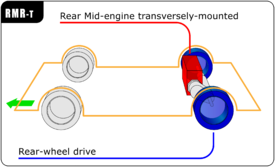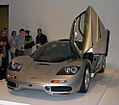Rear mid-engine, rear-wheel-drive layout
This article needs additional citations for verification. (November 2011) |


In automotive design, an RMR, or rear mid-engine, rear-wheel-drive layout (now simply known as MR, or mid-engine, rear-wheel-drive layout), is one in which the rear wheels are driven by an engine placed just in front of them (i.e., the rear axle), behind the passenger compartment. In contrast to the rear-engined RR layout, the center of mass of the engine is in front of the rear axle. This layout is typically chosen for its low moment of inertia and relatively favorable weight distribution (the heaviest component is within the wheelbase, making the main component of its moment of inertia relatively low). The layout has a tendency toward being heavier in the rear than the front, which allows for best balance to be achieved under braking. However, since there is little weight over the front wheels, under acceleration, the front of the car is prone to lift and cause understeer. Most rear-engine layouts have historically been used in smaller vehicles, because the weight of the engine at the rear has an adverse effect on a larger car's handling, making it 'tail-heavy'.[1] It is felt that the low polar inertia is crucial in selection of this layout. The mid-engined layout also uses up central space, making it impractical for any but two-seater sports cars. However, some microvans use this layout, with a small, low engine beneath the loading area. This makes it possible to move the driver right to the front of the vehicle, thus increasing the loading area at the expense of slightly reduced load depth.
In modern racing cars, RMR is the usual configuration and is usually synonymous with "mid-engine". Due to its weight distribution and resulting in favorable vehicle dynamics, this layout is heavily employed in open-wheel Formula racing cars (such as Formula One and IndyCar) as well as purpose-built sports racing cars. This configuration was also common in very small engined 1950s microcars, in which the engines did not take up much space. Because of successes in racing, the RMR platform has been popular for road-going sports cars despite the inherent challenges of design, maintenance and lack of cargo space. The similar mid-engine, four-wheel-drive layout gives many of the same advantages and is used when extra traction is desired, such as in some supercars and in the Group B rally cars.
History[]
The 1900 NW Rennzweier was one of the first race cars with mid-engine, rear-wheel-drive layout. Other known historical examples include the 1923 Benz Tropfenwagen. It was based on an earlier design named the Rumpler Tropfenwagen in 1921 made by Edmund von Rumpler, an Austrian engineer working at Daimler. The Benz Tropfenwagen was designed by Ferdinand Porsche along with Willy Walb and Hans Nibel. It raced in 1923 and 1924 and was most successful in the Italian Grand Prix in Monza where it stood fourth. Later, Ferdinand Porsche used mid-engine design concept towards the Auto Union Grand Prix cars of the 1930s which became the first winning RMR racers. They were decades before their time, although MR Miller Specials raced a few times at Indianapolis between 1939 and 1947. In 1953 Porsche premiered the tiny and altogether new RMR 550 Spyder and in a year it was notoriously winning in the smaller sports and endurance race car classes against much larger cars – a sign of greater things to come. The 718 followed similarly in 1958. But it was not until the late 1950s that RMR reappeared in Grand Prix (today's "Formula One") races in the form of the Cooper-Climax (1957), soon followed by cars from BRM and Lotus. Ferrari and Porsche soon made Grand Prix RMR attempts with less initial success. The mid-engined layout was brought back to Indianapolis in 1961 by the Cooper Car Company with Jack Brabham running as high as third and finishing ninth. Cooper did not return, but from 1963 on British built mid-engined cars from constructors like Brabham, Lotus and Lola competed regularly and in 1965 Lotus won Indy with their Type 38.
Rear mid-engines were widely used in microcars like the Isetta or the Zündapp Janus.
The first rear mid-engined road car after WW II was the 1962 (Rene) Bonnet / Matra Djet, which used the 1108cc Renault Sierra engine, mated to the transaxle from the FWD Renault Estafette van. Nearly 1700 were built until 1967. This was followed by the first De Tomaso, the Vallelunga, which mated a tuned Ford Cortina 1500 Kent engine to a VW transaxle with Hewland gearsets. Introduced at Turin in 1963, 58 were built 1964–68. A similar car was the Renault-engined Lotus Europa, built from 1966 to 1975.
Finally, in 1966, the Lamborghini Miura was the first high performance mid-engine, rear-wheel-drive road car. The concept behind the Miura was that of putting on the road a grand tourer featuring state-of-the-art racing-car technology of the time; hence the Miura was powered by a V12 transversely mounted between the rear wheels, solidal to the gearbox and differential.[2] This represented an extremely innovative sportscar at a time when all of its competitors (aside from the rear-engined Porsches), from Ferraris to Aston Martins, were traditional front-engined, rear-wheel-drive grand tourers.
The Pontiac Fiero was a mid-engined sports car that was built by the Pontiac division of General Motors from 1984 to 1988. The Fiero was the first two-seater Pontiac since the 1926 to 1938 coupes, and also the first mass-produced mid-engine sports car by a U.S. manufacturer.
Gallery[]
Mid-engine transversely-mounted, rear-wheel-drive layout[]

NW Rennzweier, first of the long line of Tatra racing cars.
The Lamborghini Miura, incorrectly accounted as the first mid-engined roadcar.
The Lancia Stratos HF was powered by a mid-transverse mounted Dino Ferrari V6, and proved to be very successful as a rally car.

Toyota MR2, Japan's first mid-engined production car.

In the Lotus Evora, platform and mechanicals are uniquely designed for the vehicle.

The Consulier GTP incorporated a mid-transverse mounted Chrysler 2.2 Turbo III engine; it was successful in IMSA competition until it was banned in 1991.

The Lancia Montecarlo sports car was developed as part of the Beta range and it is named in honour of the Stratos winning the Rallye Monte-Carlo. They were marketed in the US as Lancia Scorpion. Lampredi designed twin-cam, 4 cylinder engine.

Mitsubishi i
Mid-engine longitudinally-mounted, rear-wheel-drive layout[]

The Porsche 550 Spyder produced from 1953 to 1956.
1962 René Bonnet Djet is the world's first rear mid-engined production road car.
1963 ATS 2500 GT was the first Italian sports car to have a mid-engine layout.

Renault 5 Turbo by predecessor Renault 5.

Fiat's Lancia Rally 037, early 1980s Lancia Rally fastbacks.

Porsche 914 shared VW mechanicals and was sold in Europe as the VW-Porsche 914.
The Porsche Boxster could be considered a successor to the 914.

McLaren F1 – during its production run, the fastest production car available.

The 1973 365 GT4 BB, Ferrari's first mid-engined GT car.

The Ferrari Mondial, a production 4 seat mid-engined convertible.
References[]
- ^ Hillier, Victor; Coombes, Peter (2004). Fundamentals of motor vehicle technology. Nelson Thornes. p. 9. ISBN 978-0-7487-8082-2.
- ^ "History". Official Lamborghini website. Archived from the original on 2012-12-20. Retrieved 2012-12-04.
- ^ "Matra-Simca Bagheera". Simca Talbot Information Centre – Simca Club UK. Retrieved 2006-08-19.
External links[]
- Car layouts



















